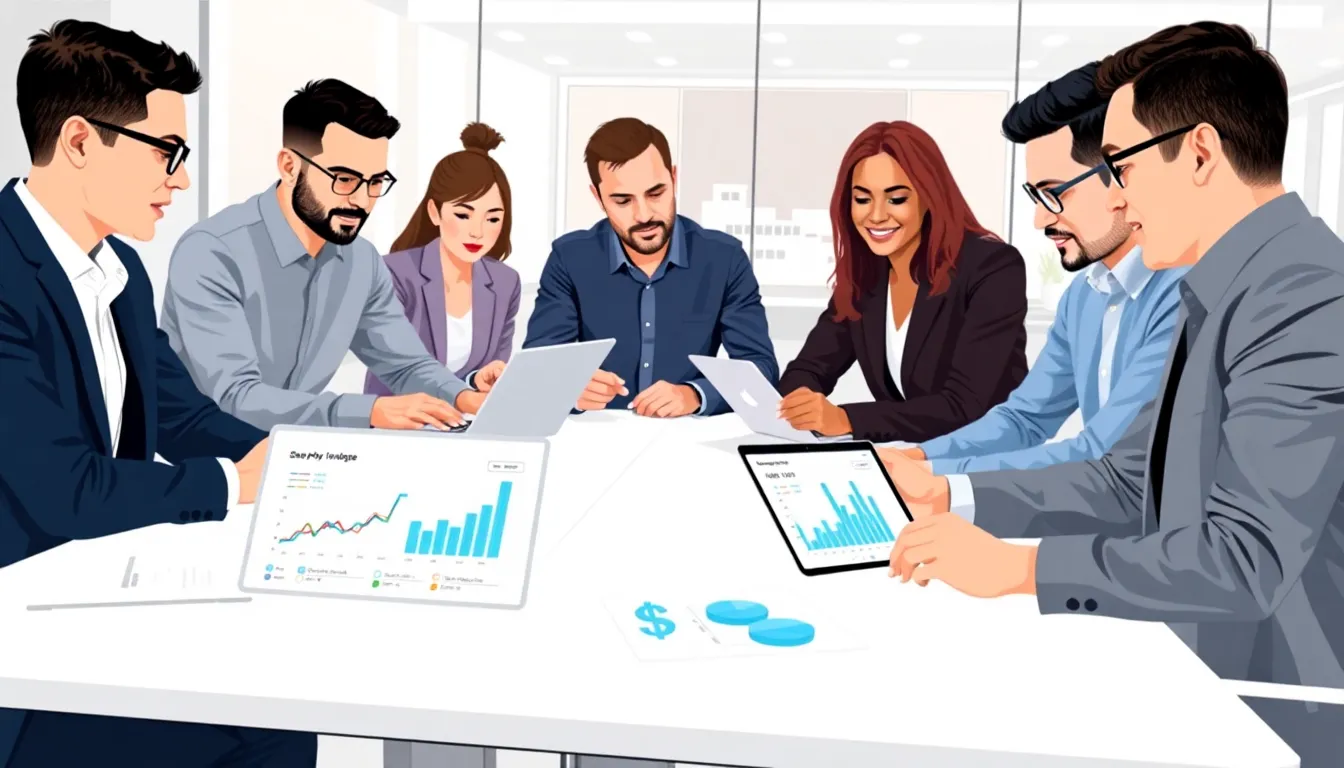In a world where procurement can feel like a never-ending game of hide and seek, emerging technologies are the trusty sidekicks every procurement professional didn’t know they needed. Imagine trading those tedious spreadsheets for smart algorithms that predict supplier performance faster than you can say “cost savings.”
Table of Contents
ToggleOverview of Emerging Technologies in Procurement
Emerging technologies significantly reshape procurement practices. These innovations enhance efficiency, accuracy, and decision-making processes. Artificial intelligence (AI) stands out by automating routine tasks and offering predictive analytics. Machine learning algorithms process vast datasets to identify trends, enabling organizations to foresee supplier performance.
Blockchain technology brings transparency to procurement. This decentralized ledger maintains a secure record of transactions, which fosters trust among stakeholders. Smart contracts automate processes, reducing delays and minimizing errors in procurement agreements.
Cloud computing plays a crucial role in facilitating data accessibility. With cloud-based platforms, procurement teams collaborate seamlessly from various locations. Real-time data sharing leads to informed decisions and quicker responses to market changes.
Robotic process automation (RPA) streamlines repetitive tasks. RPA handles invoice processing, order placement, and compliance checks, freeing professionals to focus on strategic activities. Additionally, it reduces human error, resulting in more reliable procurement operations.
Data analytics tools are fundamental in understanding supplier performance. These tools provide insights into spending patterns and supplier reliability, allowing organizations to make data-driven choices. Companies harness these insights to optimize their supply chain management.
Integration of Internet of Things (IoT) devices brings greater visibility into inventory levels. IoT sensors track stock in real-time, leading to timely reorders and reduced stockouts. Enhanced visibility also aids in identifying inefficiencies within the supply chain.
Investing in emerging technologies positions organizations for long-term success. Procurement departments benefit from increased agility and adaptability in a rapidly evolving market landscape. By embracing these innovations, they can achieve significant cost savings while improving supplier relationships and operational effectiveness.
Benefits of Adopting New Technologies

Emerging technologies yield significant benefits in procurement. Organizations can enhance their operations dramatically by adopting these advancements.
Increased Efficiency
Procurement teams increase efficiency by automating routine tasks. Robotic process automation eliminates manual work, allowing professionals to devote time to strategic initiatives. Streamlined workflows minimize delays, shortening procurement cycles and fostering faster decision-making. When cloud computing is in place, teams access data anywhere, promoting collaboration. Advanced algorithms also predict supplier performance, improving supplier management by enabling proactive adjustments. As organizations embrace these innovations, they witness a remarkable improvement in overall productivity.
Enhanced Data Analysis
Data analysis improves significantly with new technologies. Advanced analytics tools sift through extensive datasets, uncovering spending patterns and supplier reliability. Procurement professionals glean actionable insights to support informed decision-making. Artificial intelligence enables predictive analytics, forecasting trends before they occur and guiding strategic choices. Accurate data allows organizations to respond to market changes swiftly, keeping them competitive. With enhanced visibility into supplier performance, businesses strengthen relationships and negotiate better contracts. Adopting these technologies transforms data into a vital asset in procurement processes.
Key Emerging Technologies
Emerging technologies are reshaping procurement processes, driving efficiency, and enhancing decision-making capabilities.
Artificial Intelligence
Artificial intelligence (AI) automates routine tasks in procurement workflows. Predictive analytics uncover trends in supplier performance, helping teams make informed decisions faster. Organizations benefit from enhanced risk management and cost efficiencies due to AI’s ability to analyze data rapidly. For instance, AI-powered tools can forecast demand, optimizing inventory levels. This technology fosters a proactive approach to managing supplier relationships and ensures procurement professionals maintain competitiveness.
Blockchain Technology
Blockchain technology revolutionizes procurement by enhancing transparency. Secure transaction records build trust between suppliers and buyers, as every transaction is traceable. Smart contracts automate processes, reducing administrative burdens and improving payment timeliness. These features minimize fraud and errors, ultimately leading to cost savings. Adopting blockchain can strengthen supplier relationships by establishing clear accountability and facilitating seamless communication across the supply chain.
Internet of Things (IoT)
The Internet of Things (IoT) significantly improves inventory management practices. Advanced sensors track inventory levels in real-time, enabling timely reorders and reducing stockouts. Collaborating with IoT devices enhances supply chain visibility, which leads to better forecasting and strategic planning. Additionally, IoT integration provides valuable data insights that drive efficiency and optimize procurement strategies. Organizations leveraging IoT can respond swiftly to changing market demands, maintaining a competitive edge.
Challenges in Implementing New Technologies
Implementing new technologies in procurement presents various challenges that organizations must navigate effectively.
Change Management
Change management plays a crucial role in technological integration. Employees may resist shifting from established processes to new systems. Training programs can ease this transition, fostering a culture of innovation. Communicating the benefits of new technologies boosts acceptance and encourages team involvement. Leaders should address concerns promptly, ensuring everyone understands the advantages of change. Stakeholder engagement remains essential for successful implementation, promoting a collaborative atmosphere.
Integration with Existing Systems
Integrating new technologies with existing systems poses difficulties. Legacy systems often lack compatibility, complicating the transition. A thorough analysis of current infrastructure helps identify potential integration barriers. Organizations may require IT support to facilitate smooth connectivity between platforms. Prioritizing data migration ensures that critical information remains accessible during the process. Effective planning and strategy minimize disruptions, allowing for a streamlined adaptation to new technologies.
Future Trends in Procurement Technologies
Emerging technologies continue to transform procurement practices significantly. Artificial intelligence (AI) enhances risk management capabilities by analyzing data for potential issues. Machine learning algorithms refine supplier performance assessments, ultimately improving decision-making.
Blockchain’s role in procurement strengthens trust through transparent transaction records and smart contracts. Organizations experience reduced administrative burdens and streamlined processes due to this technology. Cloud computing promotes collaboration among procurement teams by providing real-time data access, fostering quick decisions.
Data analytics tools play a crucial role in uncovering spending patterns. Enhanced insights into supplier reliability lead to informed strategic planning. Robotic process automation (RPA) decreases human error by handling repetitive tasks efficiently, freeing up procurement professionals for higher-level initiatives.
The Internet of Things (IoT) improves inventory management by enabling real-time tracking of assets. Adaptation to sudden market changes becomes more manageable with improved visibility into inventory levels. Focusing on these technologies enables procurement functions to increase agility.
Facing challenges during technology integration remains a common concern. Resistance to change often occurs when trying to shift from established methods to innovative solutions. Organizations should develop tailored training programs that emphasize the benefits of new technologies to facilitate employee acceptance.
Compatibility issues with legacy systems may complicate the adoption process. Conducting a thorough analysis helps organizations prioritize necessary infrastructure upgrades. Ultimately, effective strategies and planning lead to successful integration of emerging technologies within procurement frameworks.
Emerging technologies are reshaping the procurement landscape in profound ways. By embracing innovations like AI blockchain and IoT organizations can streamline processes enhance decision-making and improve supplier relationships. The shift from traditional methods to these advanced solutions not only boosts efficiency but also positions companies for long-term success.
However the journey toward integrating these technologies isn’t without challenges. Organizations must prioritize change management and invest in training to ensure smooth transitions. By addressing these hurdles and leveraging the full potential of emerging technologies procurement teams can navigate the complexities of a rapidly evolving market with agility and confidence.




